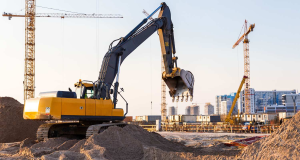Construction provides a way for individuals to make a living and contribute to the building of enduring structures that enhance our communities. It also fuels economic activity for workers and consumers, as well as attracts savers seeking a return on their investments.
It also offers variety, which is appealing to those who want challenges at work. You might work on a small residential project one day and an ambitious commercial structure the next. Click the https://jrcsi.com/ to learn more.

Although the words construction and building are often used interchangeably, they have very different meanings in the trade. Essentially, to construct means to build something, such as a road, while to build refers to the actual erecting of that something, such as a house.
This is also true of the process’s output. The construction of a team’s output may be anything from a parking lot to a skyscraper, while the output of a building is always closed structure with walls and roof. For these reasons, we prefer the term construction to describe the entire process and building to describe the process’s product. However, both are technically correct. This is simply normal usage. Nevertheless, this distinction is important to understand and avoid confusion in the field.
Getting Started
Whether you’re an experienced construction worker or just starting out, the first step is figuring out which type of role best fits you. Some roles require specialized certifications, but many entry-level positions or apprentice jobs can provide you with a good introduction to the industry and the necessary skills.
Once you’ve determined which kind of construction work interests you, consider enrolling in a trade school or applying for an apprenticeship. These programs provide an opportunity to learn a skilled trade while also earning college credits, which can help with future job opportunities. You may also want to consider working for a contractor or subcontractor to gain experience and start to build a network of contacts in the industry.
The Planning Phase is one of the most important aspects of a successful project. It ensures that all the necessary steps are completed before starting physical construction, and that a realistic timeline is established for completion. It’s a great time to work with an architect and other professionals to establish a design concept for the project, including scope, budget, and required resources.
It’s also a good idea to research local and state regulations that apply to your construction business, such as licensing requirements, labor laws, and environmental compliance. Additionally, you should establish efficient accounting systems that allow you to track your company’s finances and expenses. This will help you make informed financial decisions and fulfill tax obligations as your business grows.
Another crucial aspect of getting started is securing funding for your construction project. There are many funding options available, including commercial loans, venture capital investments, and crowdfunding platforms. You can also seek out grants from government agencies or private foundations, as well as alternative financing options like invoice factoring. It’s also a good idea to obtain general liability insurance, which protects you from claims of bodily injury or property damage caused by your construction activities. It’s vital to ensure that your business is protected, so you can focus on delivering quality results for your clients.
Planning Ahead
In construction, planning ahead is essential to minimizing stress and uncertainty, saving time and resources, and ensuring that your goals are met. This process allows you to take a proactive approach and anticipate potential problems and develop solutions before they occur, setting you up for success.
Look ahead schedules, also referred to as 3-week look-ahead scheduling, are an effective tool for construction project management. They offer a more granular level of detail into the specifics of work activities than what the overall project schedule allows, and are critical for effectively managing and monitoring a build.
The process of planning ahead starts with identifying the tasks that need to be completed, and breaking them down into manageable steps. It includes estimating the duration and determining the necessary manpower or resources needed to complete each task. Finally, it includes a schedule that details when each task will be done, and who is responsible for each step. This is updated on a weekly basis, and is an integral part of managing a construction project.
Despite the best-laid plans, construction projects will encounter scheduling challenges. These can be caused by a variety of factors, including weather, supply chain issues, client changes and delays, and other unforeseen circumstances that cannot be planned for. While many of these issues can be predicted and mitigated through careful planning, they often arise unexpectedly and can impact the project timeline.
As a result, it is important to track the progress of your construction project on a daily basis, and identify any issues as they arise. This step involves regular communication with your team and clients, and analyzing the current state of the project to determine what needs to be done. It also involves evaluating the current status of materials and equipment, and identifying any issues that need to be addressed.
By tracking and evaluating the progress of your construction project, you can better understand how well your team is performing, and make necessary adjustments as needed. This is a critical part of construction project management, and requires collaboration across the entire team to ensure that all project objectives are being achieved. Emerging technological advancements, such as artificial intelligence and advanced analytics, have the potential to transform construction scheduling, allowing for more accurate predictions and more timely adjustments.